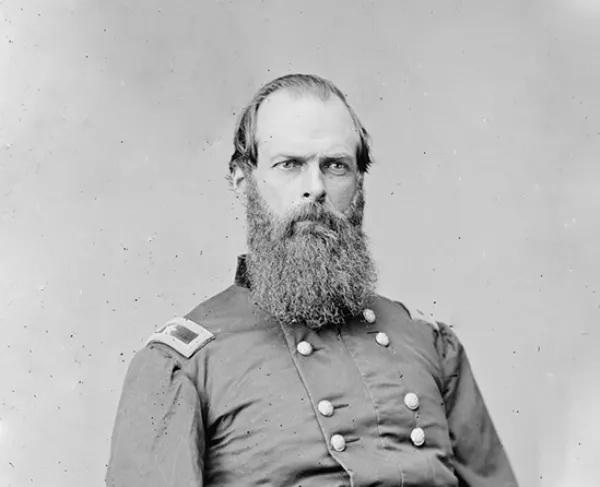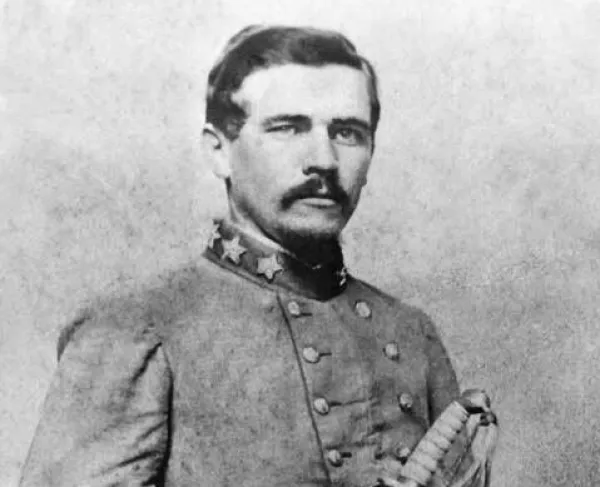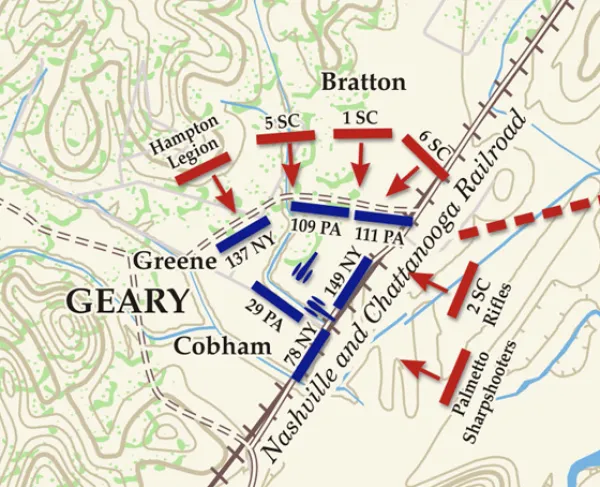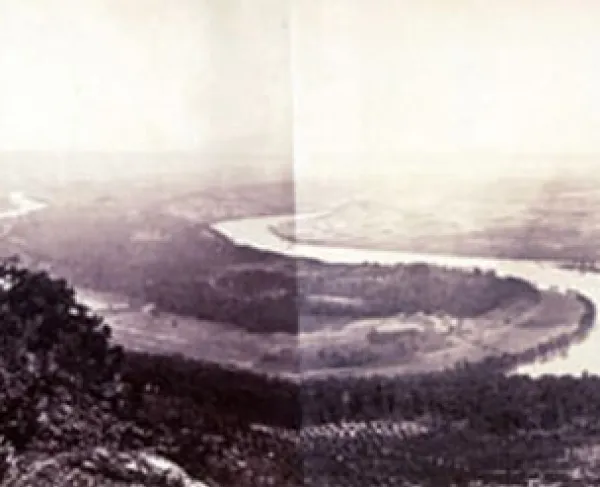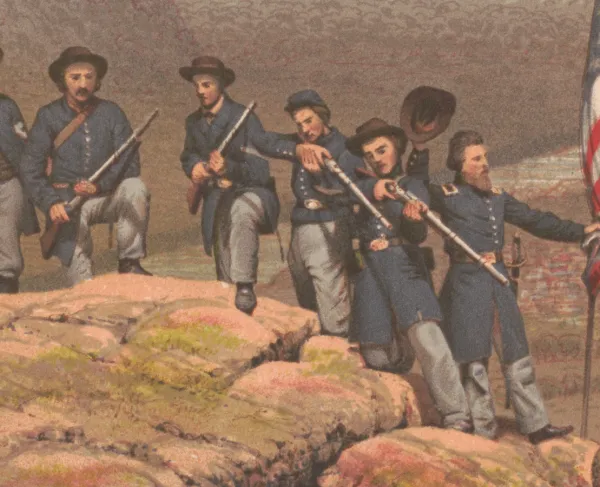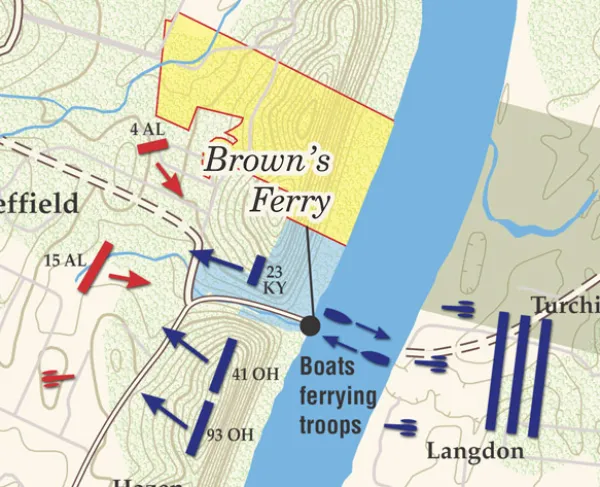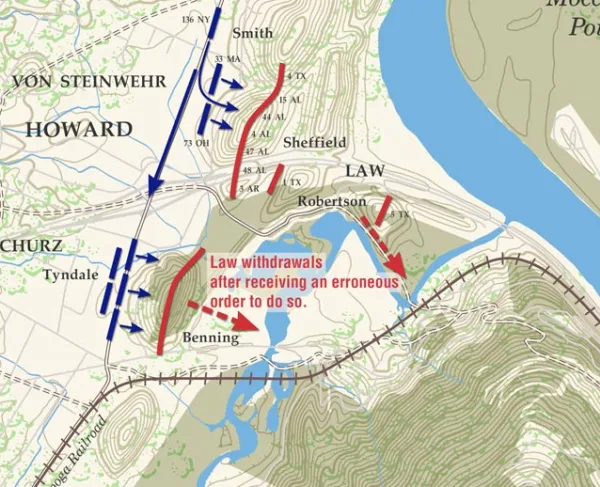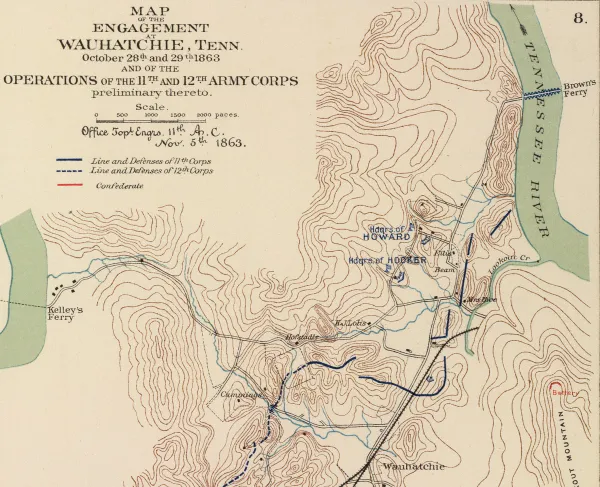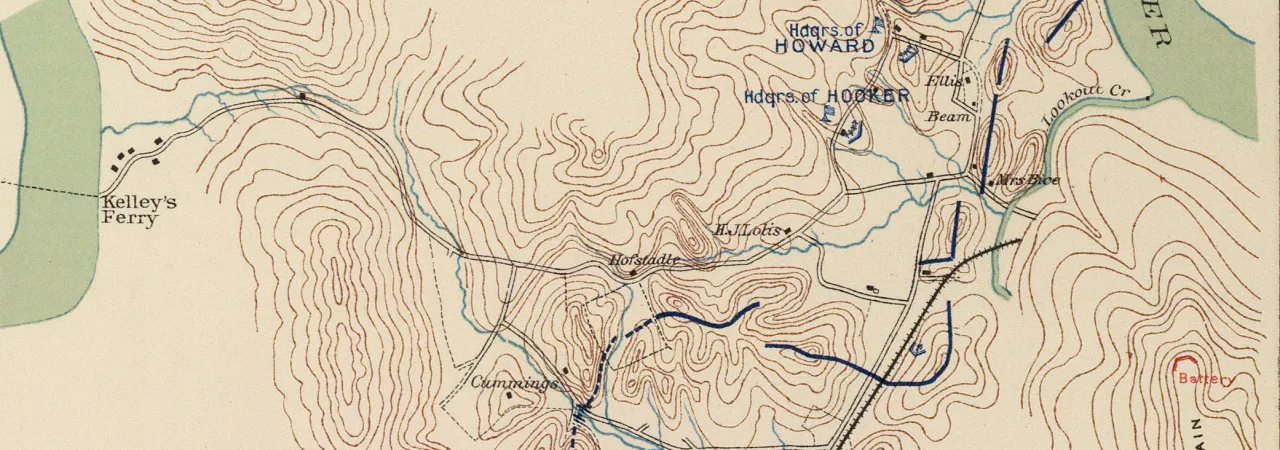
Wauhatchie
Hamilton County, Tennessee | Oct 28 - 29, 1863
The Union victory at Wauhatchie, one of the few nighttime actions of the Civil War, successfully kept open the Federal supply lines to the besieged city of Chattanooga, Tennessee. These supplies helped give the Union Army an advantage before the three-day Battles of Chattanooga the next month.
How It Ended
Union victory. The “Cracker Line Operation” was a success, and the supply lines were opened to get much-needed supplies to the Union Army in Chattanooga, Tennessee. After this defeat, the Confederate forces lost their last best chance to prevent these supplies from reaching the city.
In Context
Following Union Maj. Gen. William Rosecrans’s defeat at Chickamauga on September 18–20, 1863, the Army of the Cumberland fell back to the high ground and rail hub at Chattanooga, Tennessee. Confederate General Braxton Bragg chose to besiege the Union forces entrenched around the city, hoping to starve them into surrender.
Major General Ulysses S. Grant’s first job after replacing Rosecrans’s and being given command of all Union forces in the west was to secure supplies for the besieged Union army in Chattanooga. The “Cracker line Operation” started on October 26, 1863, and was designed to open and secure a road to Chattanooga that could bring supplies into the city.
After nearly a month of siege trapped in Chattanooga, Tennessee, the Union Army of the Cumberland made a bold maneuver to reopen their supply lines. Early on the morning of October 27, 1863, Federal troops under Brig. Gen. William B. Hazen floated down the Tennessee River on flatboats, passing beneath the Confederate guns on Lookout Mountain before landing on the opposite shore to capture Brown’s Ferry. Once captured, the first stage of the “Cracker Line Operation” was complete.
After losing Brown’s Ferry the day before, Confederate Lt. Gen. James Longstreet ordered Brig. Gen. Micah Jenkin’s division to mount a nighttime attack on Union forces under Brig. Gen. John W. Geary that were stationed near Wauhatchie Station, a stop on the Nashville and Chattanooga Railroad. While Jenkin attacked Wauhatchie, Brig. Gen. Evander M. Law and Brig. Gen. Jerome B. Robertson’s brigades were assigned to block reinforcements from reaching the scene of the battle. The attack, scheduled for 10 pm on October 28th, was delayed until 12:30 am on October 29th. Even though Union forces were aware that an attack might occur, they were still surprised by the attack.
After hearing shots being fired at Wauhatchie, Maj. Gen. Joseph Hooker ordered Maj. Gen. Carl Schurz’s division to march toward the area to reinforce Geary’s division; however, due to miscommunication, Brig. Gen. Adolph von Steinwehr’s division left instead. As they were marching toward Wauhatchie, Law’s division fired upon Steinwehr’s division and diverted their attention before they could reach the battle. They were occupied there until Law and his division retreated.
Meanwhile, the Union forces were successful in holding off Confederate attacks at Wauhatchie but were running low on ammunition. Confederate forces seemed poised to win until they were called to retreat after reports that Union reinforcements were arriving from the rear. After three hours of intense combat in the dead of night, the Battle of Wauhatchie was over.
420
408
After the defeat at the Battle of Wauhatchie, the Confederates had missed their last best chance to prevent the Union forces from reinforcing Chattanooga, Tennessee. The “Cracker Line Operation” was a success, and supplies, weapons, ammunition, and reinforcements were able to make their way through Lookout Valley and into the city. With these supplies, Union forces were primed for the three-day Battles of Chattanooga from November 23-25th. The Union victory at these battles opened up the Deep South for Union invasion and set the stage for Maj. Gen. William T. Sherman’s Atlanta Campaign the following spring.
The “Cracker Line” was a Union supply line that crossed the Tennessee River twice on pontoon bridges and fed a starving force.
After their defeat by Confederate General Braxton Bragg in September 1863 at Chickamauga, the Union Army of the Cumberland fled to nearby Chattanooga. Bragg followed and took up positions on Lookout Mountain and Missionary Ridge, obstructing Union supply lines on the Tennessee River. The lack of rations quickly began to take its toll on the besieged Union troops in the city, as well as on their horses and mules, many of which began to die from starvation. Ample supplies in Bridgeport, Alabama, were available to move to the Union troops trapped in Chattanooga, but they were 60 miles away by land, and the roads were muddy and impassable.
When Grant arrived in Chattanooga on October 23, he was approached by the Chief Engineer of the Army of the Cumberland Brig. Gen. William “Baldy” Smith, with a brilliant amphibious-land solution. Smith proposed building a bridge across the Tennessee River to establish a “Cracker Line”—a reference to the notoriously hard crackers called hardtack. His idea involved using flat-bottomed boats to transport men down the river, just under the Confederate guns on Lookout Mountain. Once they passed the guns, they would land on the left bank of the river and establish a bridgehead there, while additional troops paddled across the river from the right bank. With a crossing point firmly established, Thomas’s troops would link up with men from the XI and XII Corps under Maj. Gen. Joseph Hooker, who were marching toward Chattanooga from the southwest. It was daring but doable, and Grant approved it.
On October 27, Union forces repulsed the 15th Alabama to seize the beachhead at Brown’s Ferry. Smith’s engineers then began building a bridge across the river, which was completed by sunset. Hooker’s column marched through Lookout Valley and arrived at Brown’s Ferry at 3:45 pm on October 28. By October 29, the first supplies along the Cracker Line reached Chattanooga, improving the outlook for the enlisted men trapped there. Once the troops’ rations were assured, Grant authorized the transport of additional munitions. By the middle of November, the men were resupplied and ready to begin an offensive against Bragg.
Wauhatchie: Featured Resources
All battles of the Chattanooga-Ringgold Campaign
Related Battles
1,600
2,000
420
408
